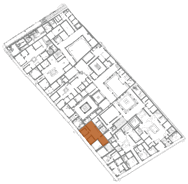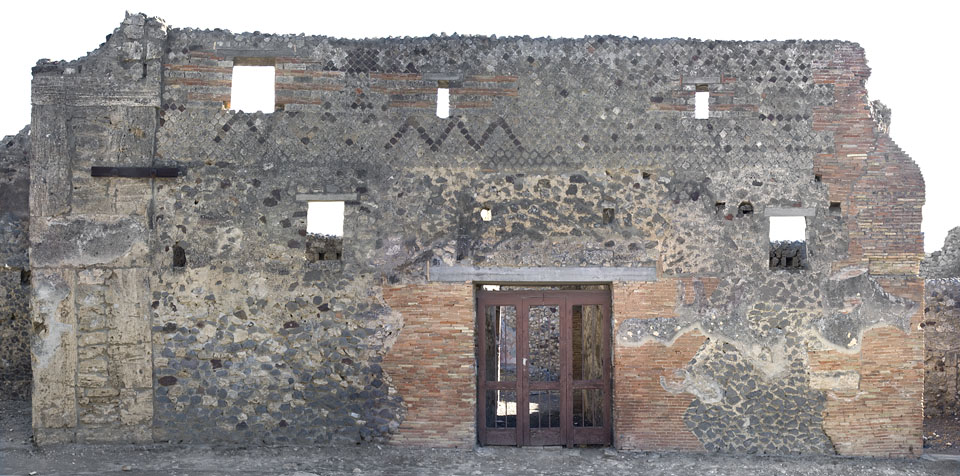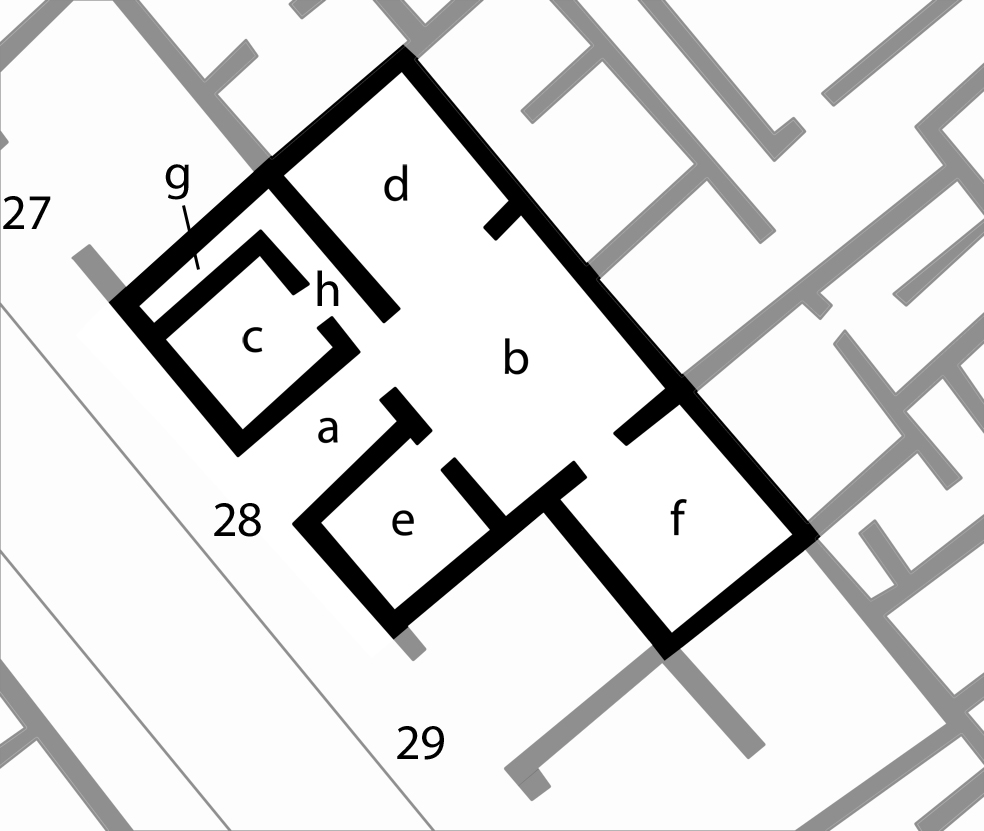V 1,28 Casa di Tofelanus Valens
Description
Thomas Staub
Casa di Tofelanus Valens, V 1,28
This house forms a small dwelling (ground area approx. 106 m²) in the southern part of the insula. The small central courtyard (room b) was reached through corridor a, which is the only room, where at least some remains of decorations are preserved, a stuccoed frieze belonging to the Fourth Style, framing the lararium niche on the north wall. The central courtyard was probably at least partly open to the sky, both for collecting rain water in a basin at the rear, east wall and for reason of illumination of the surrounding rooms in the rear part of the house. From this courtyard the four rooms and a narrow corridor, which constitutes the ground floor of the house, can be reached. As it seems, most of the ground floor was covered by an upper floor, except the courtyard, thus doubling the number of rooms, which made up the area. This upper floor was reached from the courtyard by means of a staircase whose base and first steps is placed in front of the east wall, next to the water basin.
The occupant of the house has been identified as M. Tofelanus Valens through an inscription (M TOFELANO MF VALENTI QUOD AMICO DONAVI IIS) on a marble plate in the north wall of the courtyard. Whether the gift indeed consisted of the house itself, as suggested by Della Corte or of something else we don´t know, but it seems probable that this house as well as the other entities in the southern part of the insula were part of the larger estate controlled by the owner of the Casa del Torello.
It could be, that at least parts of the house served some kind of productive function, even if the more exact profession of the occupant must remain open. In room d the material of the floor, consisting of brick tiles, of which many are lost and the covering of the lower parts of the wall with water proof plaster hints towards a productive function, may be related to the use of water from the nearby located water basin (See the description of this room for further discussions of its function). Also other rooms of the house show the same kind of plaster, as for example room e, which due to this plaster by Mau (Overbeck-Mau, 1884, 271f) was identified as the slaves sleeping room.
The narrow corridor to the north of the courtyard leads to room c with an unknown function and to the narrow room or corridor g situated in the north western corner of the house. This has been suggested as having served as latrina (Overbeck, Mau, 1884, p.271), but the floor-level seems to rise towards the west, either due a unfinished excavation or to the ancient situation. It thus seems that this function was mainly deduced from the small dimensions and off-side location. Another possible function could have as space for the staircase leading to the upper floor of the house. Also the function of room f remains unclear. Mau suggested a function as the masters and his familie´s sleeping room, mainly due to the fact that the door, as he states it, could be closed from the inside. Some installations along its east wall, amongst others a sewer from above, could instead once more hint towards a function related to some kind of production or craft.
The house shows a variety of different building techniques using different materials. Already when looking at the facade, the variety of techniques can be recognized. It starts with opus incertum of lava and sometimes limestone in a yellowish mortar, which is the material used in the original building phase. A variety of this is the more mixed opus incertum containing a wide variety of materials. The southern corner and the door posts are constructed in another technique, the opus testaceum. In the upper parts the wall is constructed of opus reticulatum of small square blocks of different materials. The zone with the upper floor windows instead is made of opus vittatum mixtum of bricks and small blocks of tuff stone. Also in the interior the walls are composed of very different materials, indicating several rebuilding phases and repairs, but it seems impossible, to clearly define the different phases and even more so to date them.
It is evident, that the house in its original lay-out was larger, extending further to the east. How far cannot be determined with any security, since it seems, that this part of the insula was restructured at some time, probably in the first half of the first century A.D., when the main house of the southern part of the insula, the Casa del Torello (V 1,7) expanded towards the west. It could thus well be, that originally this plot and the later westernmost parts of V 1,7 formed a small atrium house comparable in size with for example V 1,14, situated near the north western corner of the insula. Another hypothetical original lay-out could be in a form similar to the serial houses as firstly reconstructed by Hoffmann in Regio I and II. Anyhow, only few remains of the original building fabric are preserved. This most probably consists of the aereas of opus incertum of pure Lava set into a yellowish mortar. This Material can be observed in the certainly old partition wall between this house and its northern neighbour, the casa di Caecilio Iucundo V 1,26, i.e. the entire or parts of north walls of Rooms d, h, g. Some remains of this technique and material can also be found in the south and west wall of the courtyard b and the southern part of the facade.
Some further changes took place later in the history of the house. One consisted of the filling up of a supposed niche in the east wall in room b, another concerned room f. Here a former doorway and a window in the west wall, connecting the room with taberna V 1,29 was blocked off. This change could be explained in two ways: either the house of Tofelanus Valens was minimized and the taberna had earlier been part of the house or the house was enlarged and room f had served as a retrobotega of V 1,29 forming a two-room dwelling, just as its two neighbours to the south, V 1,30 and V 1,31. The doorway connecting room f with the courtyard b is framed by doorposts made of small tuff stone blocks, which could be seen as an indication for a later creation of this door, thus indeed indicating the original belonging to the taberna.
Decorated walls, room: a
Decorated floors, room: -
In a first discussion of the building, it was suggested, that it served as a small residential house with no hints towards a productive function. ( Overbeck - Mau 1884, 271-272). The only indication for that could be constituted in the now lost painting above the basin in room b, which depicted plants and birds on a yellow ground as a substitute for the non-existing garden as Overbeck and Mau suggests it.
Later, this house was identified as the atelier of a gold-smith by Eschebach. (Eschebach 1993, p. 128) This identification probably is based up on a mix-up in the reading of the original excavation reports. For our house just a small number of humble jewels were found: in the atrium a necklace consisting of 83 pieces of coral and in room F a small bracelet of gold and remains of Fibulae and of a mirror in silver (Gds 1875, 175-176), thus certainly not representing a unusual large group of jewels. Even if one cameo was detected during our cleaning work, it still does not indicate the work shop of a gold-smith. The only more extravagant find for a house of such small dimensions were remains of a couch made of bronze with inlays in silver, which was found in room b (Gds 1875, 176), which might have come from the collapsed upper floor. The installations in room b, d and f hints towards some kind of activity which used water and especially produced waste water.
But cf. also the short notice by E. Presuhn, Pompeji. Die neuesten Ausgrabungen, Leipzig 1882, p. I — 6: "N. 28 war ein kleines Handwerkerhaus und sieht ärmlich aus; doch wurden ein goldnes Armband, ein silberner Spiegel und ein Bett von Bronce mit eingelegtem Silber hier gefunden."
The house was excavated in 1875; further studies were undertaken by our project 2008-10.



